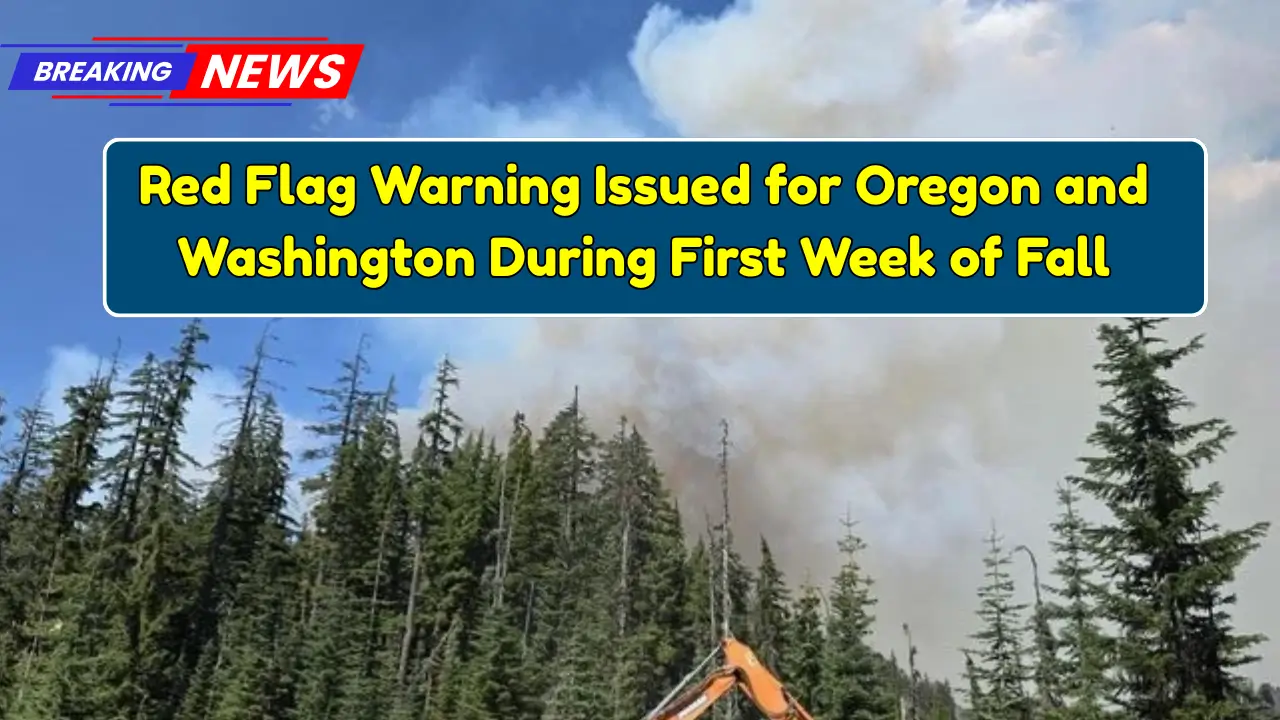A Red Flag Warning has been issued for large parts of Oregon and Washington during the first week of fall 2025, signaling extremely high fire danger due to the convergence of dry conditions, gusty winds, and low humidity.
This warning, announced by the National Weather Service (NWS), has heightened concerns among residents, fire officials, and emergency management teams across both states as the wildfire season extends deeper into the fall months.
What Is a Red Flag Warning?
A Red Flag Warning is an urgent alert issued by the National Weather Service to inform the public and firefighting agencies about impending or ongoing weather conditions that increase the likelihood of rapid wildfires spreading. It is typically triggered by a combination of several key factors:
- Strong, sustained winds or gusty winds
- Low relative humidity (usually below 20%)
- Dry fuels, such as parched grasses, shrubs, and trees
When these elements coincide, even a small ignition — like a spark from equipment or an unattended campfire — can quickly escalate into a large and dangerous wildfire.
Geographic Scope of the Warning in Oregon and Washington
The current Red Flag Warning covers multiple counties with high wildfire risk due to the preceding dry spells this summer and early fall. The table below highlights the key counties affected in each state:
| State | Counties Under Warning | Notable Features |
| Oregon | Douglas, Lane, Jackson, Klamath, Josephine | Forested regions with heavy summer fuel buildup |
| Washington | Yakima, Kittitas, Chelan, Okanogan, Klickitat | Eastern Washington drylands and forested foothills |
These counties historically experience heightened wildfire activity and have seen growing brush and forest fuel loads this year. The warning remains in effect through the early to mid-fall period, as dry conditions persist.
Meteorological Conditions Behind the Warning
The Red Flag Warning issued for Oregon and Washington is primarily driven by a high-pressure weather system settling over the Pacific Northwest, which has caused:
- Warm, dry air masses that suppress moisture and reduce humidity
- Strong northeast to east winds ranging from 15 to 30 miles per hour, with gusts up to 45 mph
- Prolonged drought conditions with minimal rainfall in recent weeks, resulting in extremely dry vegetation
Combined, these conditions create a tinderbox environment in which fires can ignite and spread rapidly.
Fire Risk and Recent Wildfire Activity
The first week of fall often marks a transitional weather period in the Pacific Northwest, but this year’s unusually dry summer has led to an extended wildfire season. Firefighters are already battling multiple smaller fires, while communities near fire-prone zones brace for potential large-scale incidents.
In the past month, several fires in these regions have been linked to lightning strikes and human-caused ignition sources. Experts warn that the current Red Flag conditions significantly increase the risk of similar or larger blazes.
Local Preparedness and Recommendations
Emergency management offices across Oregon and Washington are coordinating with firefighting agencies and community leaders to enhance readiness. Residents and visitors in affected counties are urged to take the following precautions:
- Avoid any outdoor burning or use of fire-producing equipment such as campfires, fireworks, or welding tools
- Maintain defensible space around homes by clearing dead vegetation and keeping yards trimmed
- Prepare evacuation plans and emergency kits in case rapid evacuation orders are issued
- Report any signs of smoke or fire immediately to authorities by calling 911
- Stay updated through official channels for weather alerts and fire status
Schools, parks, and recreational areas in affected regions might also impose fire restrictions or closures during the warning period.
Impact on Air Quality and Health
In addition to fire risk, wildfires and associated Red Flag conditions can cause deteriorating air quality due to smoke and particulate matter.
Vulnerable populations such as children, the elderly, and those with respiratory conditions should monitor local air quality indexes (AQI) and limit outdoor activities when smoke levels rise.
Health officials recommend the use of N95 masks indoors if smoke infiltration occurs and maintaining clean indoor air with filters and ventilation strategies.
Table: Red Flag Warning Summary for Oregon and Washington (First Week of Fall 2025)
| Aspect | Details |
| Warning Duration | Early October 2025 (first week of fall) |
| Affected States | Oregon, Washington |
| Key Weather Drivers | High pressure, dry air, gusty winds |
| Wind Speeds | 15-30 mph sustained; gusts up to 45 mph |
| Humidity Levels | Below 20% |
| Vegetation Status | Extremely dry, accumulated fuel loads |
| Fire Danger Level | Very High to Extreme |
| Recommended Precautions | No outdoor burning, defensible space |
| Air Quality Concern | Elevated risk of smoke-related health issues |
The Role of Climate Trends in Extending Fire Season
Experts emphasize that climate change has contributed to longer wildfire seasons in the Pacific Northwest by creating hotter, drier summers and milder winters.
This year’s early fall Red Flag Warning is part of a growing trend where seasonal fire risks extend beyond traditional summer months, necessitating greater year-round vigilance and adaptive fire management strategies.
Conclusion
The Red Flag Warning issued for Oregon and Washington during the first week of fall 2025 underscores the elevated wildfire danger in the region due to extreme weather and dry fuels.
Residents in affected counties must remain cautious, adhere to fire safety directives, and prepare for rapid changes in fire risk or potential evacuations. Proactive measures could avert devastating loss and protect communities as the fire season peaks into autumn.
Frequently Asked Questions (FAQs)
1. What is a Red Flag Warning and how is it different from a Fire Weather Watch?
A Red Flag Warning indicates immediate and critical fire weather conditions, while a Fire Weather Watch signifies potential upcoming hazards, allowing preparation time.
2. Which counties in Oregon and Washington are most affected by the current Red Flag Warning?
Key counties include Douglas, Lane, Jackson, Yakima, Kittitas, and Chelan, primarily in eastern and southern parts of both states.
3. What actions should residents take during a Red Flag Warning?
Avoid all outdoor fires, prepare evacuation plans, maintain clear defensible space around homes, and stay informed via emergency channels.
4. How long will the Red Flag Warning be in effect?
It is expected to last through the first week of October 2025, but could be extended or shortened depending on weather changes.
5. Does smoke from wildfires pose health risks during Red Flag conditions?
Yes, smoke can cause respiratory issues, particularly for sensitive groups; using masks and limiting outdoor exposure is advised.













